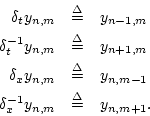A finite difference scheme is said to be
consistent with the original
partial differential equation if, given any sufficiently
differentiable function ![]() , the differential equation operating
on
, the differential equation operating
on ![]() approaches the value of the finite difference equation
operating on
approaches the value of the finite difference equation
operating on ![]() , as
, as ![]() and
and ![]() approach zero.
approach zero.
Thus, in the ideal string example, to show the consistency of Eq. (L.3) we must show that

In taking the limit as ![]() and
and ![]() approach zero, we must maintain
the relationship
approach zero, we must maintain
the relationship ![]() , and we must scale the FDS by
, and we must scale the FDS by ![]() in
order to achieve an exact result:
in
order to achieve an exact result:

as required. Thus, the FDS is consistent. See, e.g., [458] for more examples.
In summary, consistency of a finite difference scheme means that, in the limit as the sampling intervals approach zero, the original PDE is obtained from the FDS.